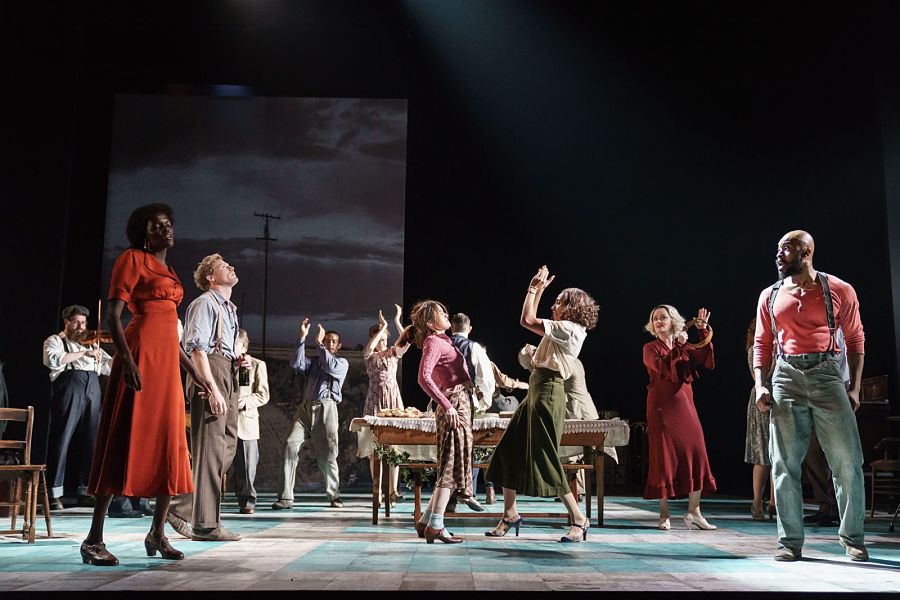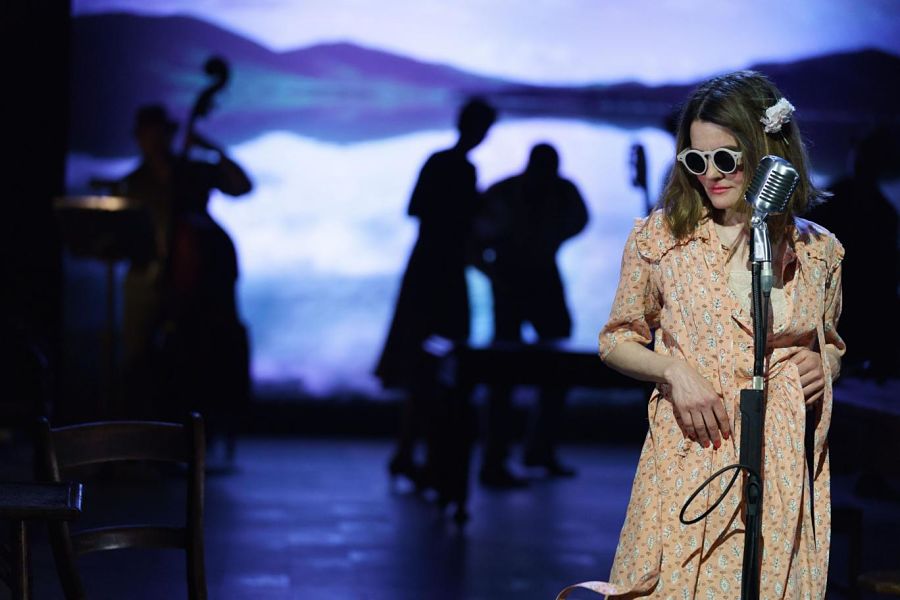Imagine Bob Dylan poring over a volume of plays by Conor McPherson, theatre’s patron saint of lost souls. He can’t put it down. In McPherson’s uplifting of Irish underdogs, Dylan recognizes the subjects of his songs. In McPherson’s quest for answers, he recognizes himself.
In reality, it’s unknown whether Dylan has read anything McPherson, including Girl From the North Country, the “Dylan musical” he encouraged McPherson to create, which will close its second run on London’s West End on March 24 after a sold-out premiere at the Old Vic. (It’s slated to play in Toronto next spring.) What we do know is that about five years ago Dylan’s manager, Jeff Rosen, contacted McPherson to see if he would be interested in using the Minnesota-born icon’s music in a theatre piece. It was a dream opportunity, but at first McPherson just couldn’t see Bob Dylan, more grit than glitz, as musical-theatre material.
But the idea simmered and, in a vision inspired by previous visits to Minnesota, McPherson conjured a guesthouse in Duluth, Minn., in the winter of 1934, halfway through the Great Depression, and the very year Robert Zimmerman’s parents wed. This backdrop may predate Dylan’s biography (he was born in 1941), but it runs in his blood. Liberated from any biographical trappings surrounding the “voice of a generation” and the genre he helped to create, it would not be a musical proper but “a play with music.”
With this world beginning to unfold, McPherson got back in touch with the Dylan camp, who made haste in delivering 40 albums to his door. This bounty came with total creative freedom, as well as the pressure to do justice to Dylan’s vast body of work, from his breakout album at the age of 20 up to his present output at 77. McPherson then cherry-picked from Dylan’s protean songbook to serve his story in the manner of soliloquies. (Following no particular chronology, the play’s songs cover most of this ground, from 1963-2012.)

Like Dylan, McPherson was a young star: At 25 his play The Weir received an Olivier Award and a Broadway run. He has since written a host of masterpieces, and in Girl From A North Country he is at his aching, humorous best. The Dylan songs are not part of the action but serve as pauses, direct-address gifts to the audience that help to chart the characters’ emotional journeys as they struggle to reconcile their American dreams with the fight to survive.
These characters include guesthouse owner Nick, played by McPherson usual suspect Ciarán Hinds, who was Olivier-nominated as Best Actor in a Musical (though he’s the only one in the cast who doesn’t sing). Nick finds himself spread ice-thin between the business; his wife Elizabeth, who has early onset dementia; their newly pregnant adopted daughter, Marianne; and their lush of a son, Gene. Both succor and added stress come from tenant/lover Mrs. Neilsen (a riveting Debbie Kurup, also up for an Olivier), on whose dead husband’s estate she and Nick have hung their hopes. Nielsen helps care sweetly for Elizabeth, and the tryst feels tender enough—until we realize Elizabeth is not entirely out of her mind.
Elizabeth is played by Shirley Henderson, a tiny marvel of gigantic presence who could pass for 20 but is in her early 50s in both life and character. Her madness is Ophelia-esque, as she speaks in babble or riddles with moments of searing truth. McPherson sees Elizabeth “as someone who has had her id entirely liberated,” and Henderson has given her hips and lips that twitch with unchecked desires and thoughts. When she takes the mic to perform “Like a Rolling Stone,” it is euphoric, a batty ballad that rolls the lunatic, lover, and poet into one. It just may join the ranks of best Dylan covers, and it helped her earn one of the show’s five Olivier nominations, including one for Best New Musical.
The rest of Nick’s guesthouse visitors include Gene’s ex-girlfriend, an old widower who is courting Marianne, an innocent ex-con boxer, and a hypocritical preacher, a failed businessman and his wife, and a formerly morphine-addicted doctor who also serves as an Our Town-style narrator. It is a motley crew that, as McPherson has said of even Dylan’s most elusive songs, entirely works.
Pregnant Marianne is the up-and-comer Sheila Atim (also up for an Olivier; the actor was on her way to becoming a doctor when her theatre career began to gather steam). Marianne came to be adopted by Nick and Elizabeth after being left on their doorstep in a bag, and the origin of her own pregnancy is dubious: The father has allegedly disappeared on a lake boat, though in another account by Marianne, he came to her—rather immaculately—in the form of wind.
McPherson and Dylan share more than an interest in “everyday heroes.” They are also both preoccupied with a kind of devout agnosticism, with Dylan taking a serious leap of faith during his notorious born-again phase. This period is officially recorded as lasting only from 1979 to 1981, but it clearly had aftershocks that influenced his lesser-lauded music from the 1980s. McPherson concentrated his play on these deep cuts, teasing out the great “Slow Train Coming” and “Saved,” as well as several songs from 1983’s Infidels and “Tight Connection to My Heart” from 1985’s Empire Burlesque, all of which set the record straight that this Dylan decade was far from fallow.

Like much of McPherson’s canon, Girl From the North Country is also populated by ghosts. Elizabeth mentions they “lost a baby girl,” and Dr. Walker tells a harrowing tale of 10-year-old Nick losing his little sister down a taconite hole, “one of those stories you hear about people, and you think about it every time you look in their face.” A forever-young Elias (Jack Shalloo), who “is in his thirties but has a mental age of a four-year-old child,” mysteriously drowns during the course of the play and comes back as a ghost “free of pain, worry or limitations,” wearing a white suit and singing a gospel version of “Dusquesne Whistle” from 2012’s Tempest.
Ten years ago for these pages McPherson told me, “All my plays are a picture of me trying to find what’s the real energy or force in my life. You have got to face the mystery of the universe, the vastness of ignorance…Human beings will probably become extinct at some point. There’s something very beautiful about that—like the universe came to life and knew itself for a little while, which is really sad, but we made art.”
He hasn’t stopped searching. The first words of Girl From a North Country, “Sign on the window says lonely,” from Dylan’s New Morning (1970), set a tone that is classic McPherson; his characters’ primary demons are loneliness and a chronic state of unrequited longing. When the chorus rises, much in the style of Dylan’s back-up singers, the 47-year-old playwright has a new refrain: Music may be the best answer of all. Friendship, generosity, and song are the life-affirming conclusions that rise up from the ashes of these burnt-up lives.
The songs for Girl From the North Country have been hand-tooled for each singer by orchestrator, arranger, and musical supervisor Simon Hale (Spring Awakening, Women on the Verge of a Nervous Breakdown). The result is an entirely new Dylan sound, different not only from his own records but also from the familiar covers by Peter, Paul & Mary, the Byrds, and Manfred Mann that garner him the most residuals on the oldies stations. Hale followed McPherson’s intent to use only 1930s instruments, and a downstage quartet includes the show’s musical director Alan Berry on piano and harmonium, Charlie Brown on violin and mandolin, Pete Callard on lap steel resonator, acoustic, and nylon steel guitars, and Don Richardson on upright bass. Upstage left, the drum set gets variously occupied by characters, most unforgettably Bronagh Gallagher as houseguest Mrs. Burke, who looks born to play the drums as she croons a bluesy “Sweetheart Like You” from Infidels, which segues into “True Love Tends to Forget” from 1978’s Street-Legal.
In Hale’s hands not only do we catch every poignant phrase but the orchestral beauty of the compositions, at which McPherson has marveled during this experience. Indeed, sung in rich, full voice and set amid the narratives of people’s lives, Girl might be the best case anyone has made yet for Dylan’s controversial Nobel.
The cast of Irish and English actors copping MinneSOWta accents, à la Brothers Coen, was hilarious to my own Duluth ear, as was the London audience response, from the Americans weeping next to me to a pair of Brits on their first Dylan high, overcome by a dead-earnest reaction to the profound metaphor of a rolling stone. I heard another woman rue the number of tunes (“I fought dere was gawntabe a bit mow moosic”), perhaps having been misled by the social handle @dylanmusical, a smart marketing move that might be a slight misnomer.
Dylan had barely shed his Hibbing High graduation gown when he left Minnesota, in search of warmer climes and cooler people, never to return. He changed his name and is now more closely associated with New York and the South than he could ever be with his home state, hard as we Minnesotans try. But perhaps this project means a great deal to the mysterious music man who is living to see his art eclipse him. No one knows if Dylan will attend the play. Perhaps he’ll catch it a little closer to his home in Malibu, when it stops in Toronto at the Mirvish next year, the only other announced engagement. Or when it inevitably comes to his home country, maybe even as close as the Twin Cities.
If he sees it, and I hope he does, whether he hides in the last row or takes an unlikely bow, I will bet my Duluth life that he loves it.
Cassandra Csencsitz is a girl from the North Country. She is now an arts and beauty writer in New York City, where she is married with children.


